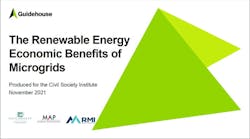The Renewable Energy Economic Benefits of Microgrids
Microgrids are increasingly becoming part of a new, modern electrical energy system. Communities, businesses, and government institutions see them as unique solutions to meet the demand for clean, resilient, and efficient energy. Breakthroughs and cost reductions in solar and battery technologies are making microgrids increasingly accessible and cost effective. Microgrids can be designed for varying sizes and purposes with a primary benefit of serving diverse community needs. For example, microgrids can link communities and provide people’s energy needs, ranging from isolated rural communities to helping support grids in large cities and regions.
Simply put, interest and adoption of microgrids are growing because they help provide reliable, affordable, and resilient energy. And as the recent hurricanes and wildfires remind us, resilient energy systems are critical to protecting people. They are the future.
Microgrids provide resiliency in the face of extreme weather and natural disasters by providing people with reliable power during large scale centralized grid outages. They protect livelihoods during times of crisis, allow critical infrastructure such as hospitals and schools to remain open, and reduce the transmission costs of energy, making electricity more efficient and less costly.
Anchored by solar and energy storage, renewable microgrid technologies could eventually provide a wide range of communities with clean energy and play a major role in a timely response to
climate change. And they can help make the transition to EVs.
What is less well known is the impact of microgrid development on jobs and the economy. To fill that gap, we commissioned this report from Guidehouse so that policymakers, businesses, and advocates could better understand the economic impact of this growing move toward microgrids. The findings prove that pursuing microgrids as a cornerstone of a more resilient America will produce well paying jobs at all levels and significantly contribute to the economy.
This report takes a high level forecast of microgrid growth nationally and provides more detail on California and Puerto Rico, two jurisdictions where resiliency has emerged as a major need.
California was selected because its fleet of microgrids has historically been more focused on renewable energy and other clean energy assets than the rest of the US. Because of public policies, this state is maximizing jobs and economic impacts attached to sustainable energy resources. Given the wildfire threats over the past 4 years and resulting power outages both planned and unplanned the need for microgrids is clear.
Puerto Rico was selected because it is a US territory where microgrids help reduce the impact of long duration power outages due to insufficient infrastructure spending in past decades. Microgrids are a key part of an overall clean energy transition to reduce the cost of imported fossil fuels.
